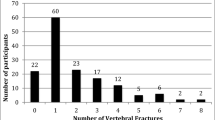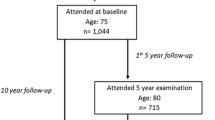Abstract
Several factors increase the risk of fragility fracture, including low bone mineral density, falls, and poor physical performance. The associations among these factors have been investigated; however, most of the subjects of previous studies were either elderly men or elderly women, and the associations were controversial. The aim of this study was to evaluate the associations between physical performance and bone mineral density, and the history of falls and fractures, stratified by gender and age group. We analyzed 5368 subjects who were aged 50 years or older, including 1288 younger men (younger than 70 years), 1615 younger women (younger than 70 years), 1087 older men (70 years or older), and 1378 older women (70 years or older). We used the one-leg standing time (OLST) for assessing static balance and the timed up-and-go test (TUGT) for assessing dynamic balance. The subjects in the worst performance quartile for the OLST were more likely to have osteoporosis than those in the best performance quartile. Additionally, women who had experienced a fracture during the past 2 years were 1.68 times more likely to be in the worst performance quartile for the OLST than women without a previous fracture. Although the TUGT time was not associated with either the incidence of osteoporosis or the fracture history, the odds ratios for falling were 1.51 and 1.28 as the TUGT time increased by one standard deviation in younger men and younger women, respectively. The findings of the present study show that the OLST was associated with the incidence of osteoporosis and previous fracture and that the TUGT time was associated with the incidence of falling.

Similar content being viewed by others
References
Johnell O, Kanis J (2005) Epidemiology of osteoporotic fractures. Osteoporos Int 16(Suppl 2):S3–S7
Johnell O, Kanis JA (2006) An estimate of the worldwide prevalence and disability associated with osteoporotic fractures. Osteoporos Int 17:1726–1733
Lee J, Lee S, Jang S, Ryu OH (2013) Age-related changes in the prevalence of osteoporosis according to gender and skeletal site: the Korea National Health and Nutrition Examination Survey 2008–2010. Endocrinol Metab (Seoul) 28:180–191
Jang S, Park C, Jang S, Yoon H-K, Shin CS, Kim D-Y, Ha Y-C, Lee S-S, Choi HJ, Lee Y-K, Kim B-T, Choi J-Y (2010) Medical service utilization with osteoporosis. Endocrinol Metab (Seoul) 25:326–339
Choi HJ, Shin CS, Ha YC, Jang S, Jang S, Park C, Yoon HK, Lee SS (2012) Burden of osteoporosis in adults in Korea: a national health insurance database study. J Bone Miner Metab 30:54–58
Nguyen T, Sambrook P, Kelly P, Jones G, Lord S, Freund J, Eisman J (1993) Prediction of osteoporotic fractures by postural instability and bone density. BMJ 307:1111–1115
Taaffe DR, Simonsick EM, Visser M, Volpato S, Nevitt MC, Cauley JA, Tylavsky FA, Harris TB (2003) Lower extremity physical performance and hip bone mineral density in elderly black and white men and women: cross-sectional associations in the Health ABC Study. J Gerontol A Biol Sci Med Sci 58:M934–M942
Albrand G, Munoz F, Sornay-Rendu E, DuBoeuf F, Delmas PD (2003) Independent predictors of all osteoporosis-related fractures in healthy postmenopausal women: the OFELY study. Bone 32:78–85
Lord SR, Menz HB, Tiedemann A (2003) A physiological profile approach to falls risk assessment and prevention. Phys Ther 83:237–252
Shin H, Panton LB, Dutton GR, Ilich JZ (2011) Relationship of physical performance with body composition and bone mineral density in individuals over 60 years of age: a systematic review. J Aging Res 2011:191896
Gerdhem P, Ringsberg KA, Akesson K (2006) The relation between previous fractures and physical performance in elderly women. Arch Phys Med Rehabil 87:914–917
Khazzani H, Allali F, Bennani L, Ichchou L, El Mansouri L, Abourazzak FE, Abouqal R, Hajjaj-Hassouni N (2009) The relationship between physical performance measures, bone mineral density, falls, and the risk of peripheral fracture: a cross-sectional analysis. BMC Public Health 9:297
Takeshima N, Islam MM, Rogers ME, Koizumi D, Tomiyama N, Narita M, Rogers NL (2014) Pattern of age-associated decline of static and dynamic balance in community-dwelling older women. Geriatr Gerontol Int 14:556–560
Persad CC, Cook S, Giordani B (2010) Assessing falls in the elderly: should we use simple screening tests or a comprehensive fall risk evaluation? Eur J Phys Rehabil Med 46:249–259
Lee K, Lee S, Song C (2013) Whole-body vibration training improves balance, muscle strength and glycosylated hemoglobin in elderly patients with diabetic neuropathy. Tohoku J Exp Med 231:305–314
Lee SH, Kwon HS, Park YM, Ha HS, Jeong SH, Yang HK, Lee JH, Yim HW, Kang MI, Lee WC, Son HY, Yoon KH (2014) Predicting the development of diabetes using the product of triglycerides and glucose: the Chungju Metabolic Disease Cohort (CMC) study. PLoS One 9:e90430
Jonsson E, Seiger A, Hirschfeld H (2004) One-leg stance in healthy young and elderly adults: a measure of postural steadiness? Clin Biomech (Bristol, Avon) 19:688–694
Carlsson H, Rasmussen-Barr E (2013) Clinical screening tests for assessing movement control in non-specific low-back pain. A systematic review of intra- and inter-observer reliability studies. Man Ther 18:103–110
Padgett PK, Jacobs JV, Kasser SL (2012) Is the BESTest at Its Best? A Suggested Brief Version Based on Interrater Reliability, Validity, Internal Consistency, and Theoretical Construct. Phys Ther 92:1197–1207
Steffen TM, Hacker TA, Mollinger L (2002) Age- and gender-related test performance in community-dwelling elderly people: Six-Minute Walk Test, Berg Balance Scale, Timed Up & Go Test, and gait speeds. Phys Ther 82:128–137
Podsiadlo D, Richardson S (1991) The timed “Up & Go”: a test of basic functional mobility for frail elderly persons. J Am Geriatr Soc 39:142–148
Ahn Y, Kwon E, Shim JE, Park MK, Joo Y, Kimm K, Park C, Kim DH (2007) Validation and reproducibility of food frequency questionnaire for Korean genome epidemiologic study. Eur J Clin Nutr 61:1435–1441
Goodpaster BH, Park SW, Harris TB, Kritchevsky SB, Nevitt M, Schwartz AV, Simonsick EM, Tylavsky FA, Visser M, Newman AB (2006) The loss of skeletal muscle strength, mass, and quality in older adults: the health, aging and body composition study. J Gerontol A Biol Sci Med Sci 61:1059–1064
Makovey J, Naganathan V, Sambrook P (2005) Gender differences in relationships between body composition components, their distribution and bone mineral density: a cross-sectional opposite sex twin study. Osteoporos Int 16:1495–1505
Frost HM (2004) A 2003 update of bone physiology and Wolff’s law for clinicians. Angle Orthod 74:3–15
Furrer R, van Schoor NM, de Haan A, Lips P, de Jongh RT (2014) Gender-specific associations between physical functioning, bone quality, and fracture risk in older people. Calcif Tissue Int 94:522–530
Karkkainen M, Rikkonen T, Kroger H, Sirola J, Tuppurainen M, Salovaara K, Arokoski J, Jurvelin J, Honkanen R, Alhava E (2009) Physical tests for patient selection for bone mineral density measurements in postmenopausal women. Bone 44:660–665
Daly RM, Bass SL (2006) Lifetime sport and leisure activity participation is associated with greater bone size, quality and strength in older men. Osteoporos Int 17:1258–1267
Verbrugge LM, Jette AM (1994) The disablement process. Soc Sci Med 38:1–14
Sun W, Watanabe M, Tanimoto Y, Kono R, Saito M, Hirota C, Kono K (2009) Assessment of the best gait parameter in relation to bone status in community-dwelling young-old and old-old women in Japan. Arch Gerontol Geriatr 49:158–161
Zhu K, Devine A, Lewis JR, Dhaliwal SS, Prince RL (2011) ‘Timed up and go’ test and bone mineral density measurement for fracture prediction. Arch Intern Med 171:1655–1661
Tan BK, Price RI, Briffa NK, Dhaliwal SS, Day RE, Singer KP (2008) Assessment of osteoporotic fracture risk in community settings: a study of post-menopausal women in Australia. Health Soc Care Community 16:621–628
Sakai A, Toba N, Takeda M, Suzuki M, Abe Y, Aoyagi K, Nakamura T (2009) Association of unipedal standing time and bone mineral density in community-dwelling Japanese women. Osteoporos Int 20:731–736
Lin MR, Hwang HF, Hu MH, Wu HD, Wang YW, Huang FC (2004) Psychometric comparisons of the timed up and go, one-leg stand, functional reach, and Tinetti balance measures in community-dwelling older people. J Am Geriatr Soc 52:1343–1348
Shumway-Cook A, Brauer S, Woollacott M (2000) Predicting the probability for falls in community-dwelling older adults using the Timed Up & Go Test. Phys Ther 80:896–903
Sletvold O, Tilvis R, Jonsson A, Schroll M, Snaedal J, Engedal K, Schultz-Larsen K, Gustafson Y (1996) Geriatric work-up in the Nordic countries. The Nordic approach to comprehensive geriatric assessment. Dan Med Bull 43:350–359
American Geriatrics Society, British Geriatrics Society, American Academy of Orthopaedic Surgeons Panel on Falls Prevention (2001) Guideline for the prevention of falls in older persons. J Am Geriatr Soc 49:664–672
Schoene D, Wu SM, Mikolaizak AS, Menant JC, Smith ST, Delbaere K, Lord SR (2013) Discriminative ability and predictive validity of the timed up and go test in identifying older people who fall: systematic review and meta-analysis. J Am Geriatr Soc 61:202–208
Nordin E, Lindelof N, Rosendahl E, Jensen J, Lundin-Olsson L (2008) Prognostic validity of the Timed Up-and-Go test, a modified Get-Up-and-Go test, staff’s global judgement and fall history in evaluating fall risk in residential care facilities. Age Ageing 37:442–448
Ganz DA, Bao Y, Shekelle PG, Rubenstein LZ (2007) Will my patient fall? JAMA 297:77–86
Greendale GA, DeAmicis TA, Bucur A, Bretsky P, Rowe JW, Reuben DB, Seeman T (2000) A prospective study of the effect of fracture on measured physical performance: results from the MacArthur Study–MAC. J Am Geriatr Soc 48:546–549
Scheffer AC, Schuurmans MJ, van Dijk N, van der Hooft T, de Rooij SE (2008) Fear of falling: measurement strategy, prevalence, risk factors and consequences among older persons. Age Ageing 37:19–24
Lundin H, Saaf M, Strender LE, Nyren S, Johansson SE, Salminen H (2014) One-leg standing time and hip-fracture prediction. Osteoporos Int 25:1305–1311
Karkkainen M, Rikkonen T, Kroger H, Sirola J, Tuppurainen M, Salovaara K, Arokoski J, Jurvelin J, Honkanen R, Alhava E (2008) Association between functional capacity tests and fractures: an eight-year prospective population-based cohort study. Osteoporos Int 19:1203–1210
Eastell R, Reid DM, Compston J, Cooper C, Fogelman I, Francis RM, Hay SM, Hosking DJ, Purdie DW, Ralston SH, Reeve J, Russell RG, Stevenson JC (2001) Secondary prevention of osteoporosis: when should a non-vertebral fracture be a trigger for action? QJM 94:575–597
Morosano ME, Menoyo I, Caferra DA, Sanchez A, Tomat MF, Bocanera R, Pezzotto SM, Masoni AM (2011) Vulnerability of healthy vertebrae in patients with and without previous vertebral fracture. Bone 48:820–827
Honkanen K, Honkanen R, Heikkinen L, Kroger H, Saarikoski S (1999) Validity of self-reports of fractures in perimenopausal women. Am J Epidemiol 150:511–516
Acknowledgments
This work was supported by a research grant from the Investigator-Initiated Studies Program of Merck & Co., Korea. The funders had no role in study design, data collection and analysis, decision to publish, or preparation of the manuscript. The authors thank all the survey personnel and the officers in Chungju Health Center for continued support.
Conflict of interest
The authors declare that they have no conflict of interest.
Author information
Authors and Affiliations
Corresponding author
About this article
Cite this article
Lim, Y., Kim, K., Ko, SH. et al. Gender- and age-group-specific associations between physical performance and bone mineral density, falls, and osteoporotic fractures in Koreans: the Chungju Metabolic Disease Cohort study. J Bone Miner Metab 34, 336–346 (2016). https://doi.org/10.1007/s00774-015-0674-2
Received:
Accepted:
Published:
Issue Date:
DOI: https://doi.org/10.1007/s00774-015-0674-2




